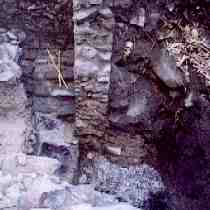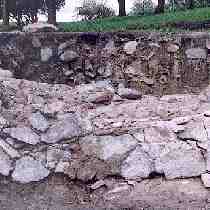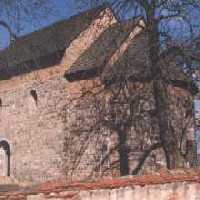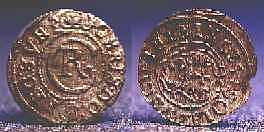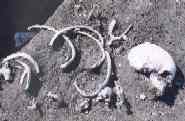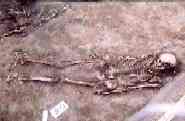
Giecz
In the year 2000 the excavation season in Giecz lasted since the beginning of July till the mid-November. The excavation work took place mostly in the stronghold, where the research on the stronghold church was continued. Also, the archeological penetration of the interior of the Romanesque church under the invocation of St. Nicholas, which is situated in the market settlement, has been finished. The excavations were financed by the Provincial Monument Restorer of Poznań and conducted by Teresa Krysztofiak, M.A.
The lack of funds did not allow for the planned for this year wide surface exploration of neighboring from the north cemetery and the bordering settlement. Thanks to cooperation with befriended Slavia Foundation, as well as the financial help of archeological company Archeo-Octo from Poznań, continuing research of this site was possible, although to the limited extent. Students of Archeology from Great Britain and the United States who came to Wielkopolska region participating in the project Slavia'2000 organized by the mentioned Foundation, took part in the excavations. The research was conducted by Elżbieta Indycka, M.A.
Stronghold church
During the 3rd excavation season, the research on stronghold church was focused on several issues:
- reconnoiter of the southern part of the crypt (not examined so far connection of the chamber with the corridor);
- elucidating characteristics of the wall encompassing the North-East corner of the church nave;
- determining characteristics and chronology of the wall of so called north wing;
- clarifying problematic issues concerning west massif, as well as gaining information specifying dating of western facade;
- obtaining as wide as possible context of researched relics through the researching transverse profile in the north and south direction.
Since the fieldwork yielded a crop of many new and often surprising data, it is difficult to draw any binding conclusions before analyzing the new material. That is the reason for presenting only the most important results of the excavations.
During the exploration of the southern part of the crypt, the last step of the exit stairway was uncovered.
The crypt's corridor was turned towards the chamber on the square quite rapidly descending at the same time. It was approximately 1.8 m wide. The passage to the crypt was depleted of the width of the corridor (ca. 0.9 m) added to the corner. Another new element clarifying the detailed construction of the crypt was gaining data proving its usable floor space had been enlarged in the west direction. However, penetrating this part of the building because of the preserved relics require conservatory work.
Research in the Northeast corner of the nave led to uncovering a later, outside entrance to the crypt. Some attention requires a very well preserved thick layer of plaster showing on the interior of the vault arch of the entrance. With this wall a newly uncovered relic is connected. This relic, in the lower part, is tightly sticking to the exterior apse and in the upper part laying on its coping. Unfortunately, the time restrictions did not allow for finishing research in this section. The research was discontinued before reaching the usable level, without which it is impossible to properly interpret the uncovered structure. The final conclusions concerning the mentioned structure require more research.
While the exploration of the western massif, the founding of the north tower was investigated. As it turned out, the tower was build on a solid and deep (ca. 1.5 m) foundations made of pebbles cemented with a gray and gray and white mortar. In a small sounding a coping of the ground wall of this tower made by using the opus in caertum technique was uncovered. In the debris layer of western facade towers several pieces of bells were localized.
In the light of the recent research conducted in the northern part of the church nave, the prior findings concerning the chronological relations between the foundations of the church nave and the foundations of the so called north wing should be verified. The north wing was build somewhat later and its foundations were added to the nave foundations. The initial analysis of the preserved parts of the ground wall and the context of its uncovering lead to a conclusion that it was an enterprise divided into two parts and it had never been finished.
Research in the transverse excavation in the south direction uncovered another parts of the church nave. As a consequence 2/3rds of the nave's width had been penetrated. At the excavation site no trace of pillars proving the inner division of the church had been found. This confirms the prior presumptions about the church being one-nave only.
The last point of this year research plan were excavations in the north part of the stronghold fortifications. It was to enable gaining as wide as possible range of architectural relics and uncovering contemporary to them wall. It would be also important to gain well preserved construction wood in order to check a hypothesis about Giecz as a stronghold from the tribe period, which arouse in the previous year. As the outcome of the research, an impressing stone mantle facing from the outside the embankment of the phase 2, which was distinguished in the previous year, was uncovered. This mantle is older than the architecture of the northern part of the stronghold. Several pieces of well-preserved wood were extracted from its foundations. We are looking forward to the results of dendrochronological analysis.
Church under the invocation of St. Nicholas
In the year 2000 the research work in the church focused on the last available for the archeological penetration part, namely the southern part of the apse (south of the foundations of the Romanesque mensa).
Under the mixed contemporary layer with the average thickness of ca.1 m, which is to be found on the whole excavation site, apart from the considerable amount of loose human bones, the last fragment of the grave that was registered back in 1993. Gray and white mortar had been reached. It cemented a horizontal layer of large broken stones coming to the mensa foundations and added to the outside face of the church coming from the phase 1 and overlapping the inside face of the foundations of the church apse from the phase 2. This relic, partially uncovered in 1993 and 1998, was believed to be remains of the older church. The right conclusions as to this relic can be drawn only after a detailed analysis supported by comparative material.
The excavation was situated in a place allowing for a complete uncovering of the foundations of the apse from the phase 2. The apse's wall placed on 5 layers of large, at times slightly trimmed erratic stones, which were cemented with gray and white mortar.
In the excavations a considerable amount of ceramics, window glass and crockery, devotional articles and 11 coins were gained. As the result the numismatic collection grew to 688 coins, which makes it the biggest of all Polish church coin collections. Preparational works to the analysis of all results of the excavatory research are in progress.
Cemetery and the bordering settlement
Determining of the northeast border of the site was the target of this year excavation season. For the inconsiderable funds, it was possible to create only two trenches (0.5 are big), which were the continuation, in the north direction, of the eastern part of the trench that was explored last year. As the result of the uncovering of 17 graves, the total number of graves increased to 72. Most of them were to be found directly under humus and as such had been destroyed by deep ploughing. Only skeletons from 4 graves that had been found deeper under ground were better preserved. The graves were usually without clear-cut boundaries, only in two cases they were distinctly visible rectangles with slightly rounded corners. In one of them wood trace had been found (a box, a casket?). All the graves were on the East-West axis with heads to the west. Skeletons were lying straight on their backs with their hands along trunks. There was one exception of a skeleton laying on its left side.
Because of the serious damage of the graves, it was not possible to assign to each one of them numerous temple bows, knives and glass beads, which were found loose but, no doubt, belonged to grave accessories. Only in one grave an iron knife had been found.
Under the layer containing graves, the remains of a settlement with cultural layers, several objects and a road padded with wood had been found. Stratigraphy of the mentioned layers together with the excavated ceramics confirms conclusions about two phases of the functioning of the settlement.
Within the excavations the northern border of the settlement from the phase 1 (8th through 9th c.) had been found. The extent of the later settlement (10th through mid 11th c.), being the bordering settlement, was greater and exceeded the explored region. The mentioned road, which corresponds to the one found last year in the western part of the explored site, is connected with this phase of settlement. It is possible that the uncovered fragment of the road is a continuation of the road found last year.
This year excavations enriched the data available on Giecz stronghold. However, they did not lead to determining the northeast reach of the site (cemetery and the border settlement). So we hope the research will be continued.
More about Giecz:

|

|
Rezerwat Archeologiczny – Gród Piastowski w Gieczu Grodziszczko 2, 63–012 Dominowo |
|
